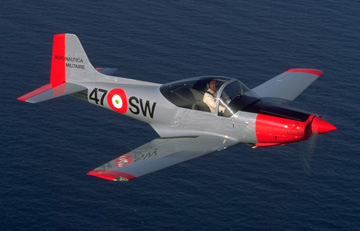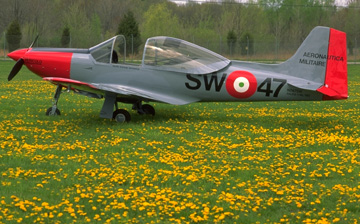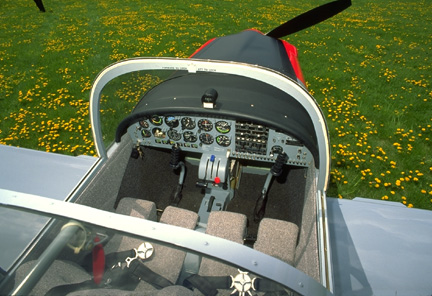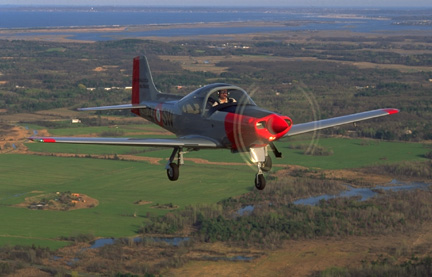Building a Falco,
Part V
![]()
Building a Falco,
|
|
In which our hero describes the aftermath of a gear-up landing, and ponders on the many advantages--and a few limitations--in owning a sophisticated homebuilt rather than a production aircraft.
by Stephan Wilkinson
This article appeared in the July 1992 issue of Pilot magazine in England.

Last year, I saw more of the FAA than I had in all 25 previous years of my flying career. I had built a Falco F.8L airplane (as readers of this magazine probably are tired of hearing), and now it was my job to flight-test and certificate this handsome little Italian thoroughbred. Mine and the FAA's, that is.
Unfortunately, the task was complicated by a friend who managed to land my Falco on its belly only days before the airplane was to have been 'signed off'-- awarded its experimental certification.
"Is he still your friend?" asks virtually everybody who hears this statement. Of course he is. The only pilots who don't understand how easy it is to land gear-up are those who have never flown a retractable. (Even a C-5A, which has 28 wheels to forget, was once inadvertently landed on its immense belly.) The incident was also only partially my friend's fault, accountable as well to the retraction mechanism's design which has since been modified by Sequoia Aircraft, the Falco plans-and-kits marketers. The landing gear froze in the up position, due to a jammed screwjack, and the pilot, distracted by traffic and his first night approach in the airplane, never noticed that putting the gear handle down had resulted only in a popped gear-motor circuit breaker.
Yet despite numerous annoyances, minor outrages and my misbegotten feeling that the FAA was being obstinate and blindly bureaucratic, the whole adventure made it obvious that American homebuilders have a degree of freedom and self-sufficiency unrivaled--even unimagined--by pilots elsewhere in the world.
For example: whether through divine grace, oversight or sheer courtesy--and I know the latter was the case in at least some of the proceedings--two different offices of the FAA allowed both me and my forgetful friend to commit violations that any true bureaucrat would have employed to ensure that neither of us ever so much as boarded an airliner again, much less piloted ourselves.
At the time of the incident, the Falco was legally restricted to day-VFR operations within a radius of 25 miles of its home base--Poughkeepsie, New York--with no passengers allowed. The gear-up occurred about 150 miles from Poughkeepsie, at night, during the return from a 1,200 mile cross-country voyage... and my friend was carrying a passenger. (He was under the misapprehension that because the airplane had indeed flown its specified limit of test hours, it was no longer bound by the test-period restrictions. Unfortunately, such freedom awaited the actual award of the proper experimental certification.)

Yet not a single violation was filed by the FAA Flight Standards District Office that thoroughly investigated the incident in Massachusetts. "You might have lucked out and gotten some of the Nice Guys," an executive at the EAA offices in Oshkosh, Wisconsin laughed when I told him what unaccountably had happened.
My own flirtation with the Federal Aviation Regulations took place soon thereafter. With the airplane temporarily repaired and flyable, I retrieved by little dear--flew it home to Poughkeepsie, wheels dangling and gear doors removed, to effect the permanent repairs in my own comfy hangar.
"Oh yeah, we had a little problem with the gear and did one belly slide," I babbled into the telephone some weeks later, "but that's all fixed now." The FAA examiner at the Teterboro, New Jersey district office listened patiently. "Happened up near Boston, but we flew 'er back and she's all fixed. I'm ready for the final inspection." Pant, pant. I was a puppy ready to do my tricks and be patted, signed off and freed to fly.
Silence. Deep breathing. "Did you report the incident to this office?" he asked.
"Uh, no."
"Did you know that means the airplane's temporary airworthiness certificate has been invalid ever since?"
"Uh, no."
"It's right there on that document you signed--paragraph 11, on the back."
As far as I was concerned, "that document" told me I could go fly around in a big circle until the flight-test period was over and that I shouldn't do anything terminally stupid like buzz midtown Manhattan or sell rides. I'd never really bothered to read beyond that.

"You say you flew it back from Boston?"
Finally, I realized I was dancing in deep excrement. "Ahhh, no, I didn't exactly say that. Somebody else flew it back."
"Somebody who?"
"Somebody else."
It was a standoff. The FAA man knew I was fibbing, but he knew that short of subpoenaing my logbook--where, like any compulsive pilot, I had faithfully recorded my transgression in detail--he couldn't prove who had been at the controls that day.
My punishment? I was made to fly the Falco an extra ten hours before again being eligible for my final airworthiness certificate. None of it was meant as "punishment", however. The FAA simply wanted to see if whatever caused the gear-up landing would recur, or if hidden damage incurred during the incident would surface.
Hidden damage... therein lies--doesn't it always, for a writer?--a tale. In the U.S., there are two basic kinds of homebuilt aircraft: those powered by proven, certificated aircraft powerplants, such as Lycomings or Continentals with time-honored Hartzell or McCauley propellers. And those powered by uncertificated powerplants: two-strokes, converted GPU's, reworked automobile beaters, wildly modified recips with handmade wooden or composite props.
So the FAA made a basic rule: homebuilts with certificated powerplants need 25 hours of test-flying to prove they wouldn't fall on peoples' heads. Homebuilts with uncertificated powerplants require forty hours to prove that their snowmobile fanbelt or Subaru hill-holder wouldn't malfunction in flight.
For some reason, the Teterboro FAA examiner in charge of my Falco project decreed that its zero-time Lycoming IO-360-B1E and brand-new Hartzell constant-speed prop constituted a risky "uncertificated powerplant." Whatever for? Because just as was the case with every other kit-built Falco flying, I'd mounted the engine's throttle body on an air-intake elbow with a 45-degree bend rather than the original's straight pipe. I was condemned to forty hours of flight-testing rather than 25.

If this seems a small price to pay, remember that it constitutes an extra 900 minutes (at a cost of $1.10 per minute, I'd estimated) of driving around and around the same little piece of airspace, the entire diameter of which the Falco was able to cross in just under fifteen minutes. Big-time boring.
But this quixotic FAA decision--no other Falco engine had ever been deemed uncertificated--now became an important factor. For the Teterboro FAA Manufacturing and Inspection District Office now announced that it would require retroactive adherence to all airworthiness directives that had been issued between the time of my Falco's gear-up landing and the date--several months later--when I'd finally reported the incident to Teterboro.
Teterboro knew that one very expensive AD had been issued during that time: any piston Lycoming that had suffered a prop strike henceforth needed a complete teardown, examination and reassembly. My engine had indeed damaged its prop, but in a manner so gently progressive that the engine never underwent the "sudden stoppage" that causes internal damage. A dial check of the crankshaft and consultation with Mattituck Airbase, the overhauler that had built up the engine only forty-odd hours earlier, assured us that all was well inside the Lycoming, and the engine was signed off for flight some days before the expensive teardown AD went into effect.
Tough darts, the FAA said. Pull that engine out and take it apart.
Suddenly, I realized my one advantage. "That AD affects Lycoming engines, right?" I asked the FAA man.
"Yup. Sure does," he smugly said.
"Then it doesn't affect me." (Dangle the lure.)
"Why not?"
"I don't have a Lycoming." (Set the hook.)
"Sure ya do. Says right here it's an IO-360-B1E."
"No, that's wrong. It's a Wilkinson 360-B1E. It's an uncertificated powerplant. You said so yourself." (Reel in the trophy.)
Silence again. More deep breathing. "Okay, but you've still gotta fly another ten hours."